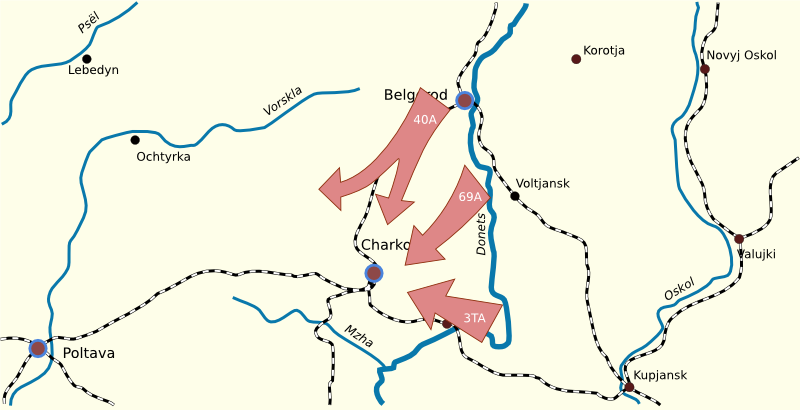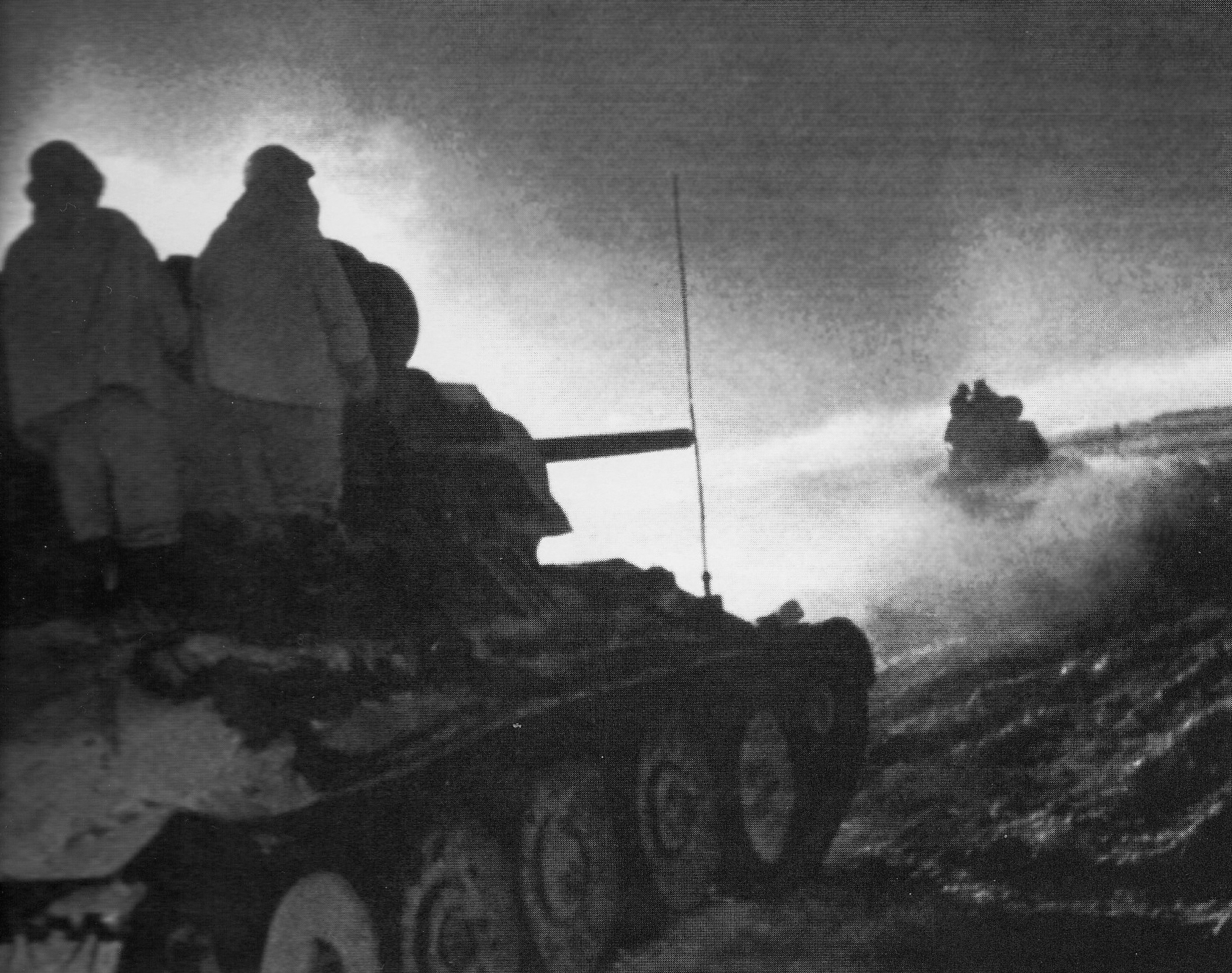|
Voronezh–Kharkov Offensive
The Voronezh–Kharkov strategic offensive operation was a successful strategic offensive operation of the Red Army's Voronezh, Bryansk and South-Western fronts, carried out from January 13 to March 3, 1943 with the aim of defeating the German Army Group B and liberating a large territory and the important industrial and administrative centers Voronezh, Kursk, Belgorod and Kharkov. Prelude In the winter of 1942/43, the Red Army launched several large offensives on the southern part of the Eastern Front in the wake of the Battle of Stalingrad. In late December, at the same time as the German 6th Army was increasingly enclosed in Stalingrad by the troops of Konstantin Rokossovsky, the troops of the Southwestern Front defeated the Italian 8th Army as part of the Operation Little Saturn and reached the line Novaya Kalitwa – Markovka – Volozhin – Chernikovsky. The Stawka planned in the course of these successes a major strategic operation, which aimed at cutting off all German ... [...More Info...] [...Related Items...] OR: [Wikipedia] [Google] [Baidu] |
Eastern Front (World War II)
The Eastern Front of World War II was a Theater (warfare), theatre of conflict between the European Axis powers against the Soviet Union (USSR), Polish Armed Forces in the East, Poland and other Allies of World War II, Allies, which encompassed Central Europe, Eastern Europe, Northern Europe, Northeast Europe (Baltic states, Baltics), and Southeast Europe (Balkans) from 22 June 1941 to 9 May 1945. It was known as the Great Patriotic War (term), Great Patriotic War in the Soviet Union – and still is in some of its successor states, while almost everywhere else it has been called the ''Eastern Front''. In present-day German and Ukrainian historiography the name German-Soviet War is typically used. The battles on the Eastern Front of the Second World War constituted the largest military confrontation in history. They were characterised by unprecedented ferocity and brutality, wholesale destruction, mass deportations, and immense loss of life due to combat, starvation, expos ... [...More Info...] [...Related Items...] OR: [Wikipedia] [Google] [Baidu] |
Southwestern Front (Soviet Union)
The Southwestern Front was a front of the Red Army during the Second World War, formed thrice. It was first created on June 22, 1941 from the Kiev Special Military District. The western boundary of the front in June 1941 was 865 km long, from the Pripyat River and the town of Wlodawa to the Prut River and the town of Lipkany at the border with Romania. It connected to the north with the Western Front, which extended to the Lithuanian border, and to the south with the Southern Front, which extended to the city of Odessa on the Black Sea. Operational history The Southwestern Front was on the main axis of attack by the German Army Group South during Operation Barbarossa. At the outbreak of war with Germany, the Front was commanded by Mikhail Kirponos and contained the Soviet 5th, 6th, 26th, and 12th Armies along the frontier. 16th 16 (sixteen) is the natural number following 15 and preceding 17. 16 is a composite number, and a square number, being 42 = 4 × 4. It i ... [...More Info...] [...Related Items...] OR: [Wikipedia] [Google] [Baidu] |
60th Army (Soviet Union)
The Red Army's 60th Army was a Soviet field army during the Second World War. It was first formed in reserve in the Moscow Military District in October 1941, but soon was disbanded. It was formed a second time in July 1942, and continued in service until postwar. The 60th Army was commanded by Gen. Ivan Danilovich Chernyakhovsky for much of the war, and it was while in this command that he proved himself worthy to be promoted to the rank of General of the Army and command of a Front at the age of 38 years. Elements of the army went on to, among other things, liberate the Auschwitz concentration camp. First Formation The 60th Army was first formed in October 1941, as a reserve formation of the Moscow Military District. It comprised the 334th, 336th, 348th, 358th, and 360th Rifle Divisions and the 11th Cavalry Division. All these divisions had been formed in the Volga Military District in the preceding months. The army was under the command of Lt. Gen. M.A. Purkayev. In Decemb ... [...More Info...] [...Related Items...] OR: [Wikipedia] [Google] [Baidu] |
Operation Star
Operation Star or Operation Zvezda (russian: Звезда, lit=Star) was a Red Army offensive on the Eastern Front of World War II begun on 2 February 1943. The attack was the responsibility of the Voronezh Front under the command of Filipp Golikov and a part of the larger Voronezh-Kharkov Strategic Offensive Operation. Its main objectives were the cities of Kharkov and Kursk. While initially successful in capturing both cities, the Soviets overextended themselves, allowing German field marshal Erich von Manstein to launch a counteroffensive and inflict a defeat on the Soviets in the Third Battle of Kharkov. See also * Case Blue * Operation Gallop Operation Gallop (russian: Операция Скачок, translit=Operatsiya Skachok) was a Soviet Army operation on the Eastern Front of World War II. The operation was part of a series of counteroffensives after the encirclement of Stalingra ... References Battles and operations of World War II Battles and operations of ... [...More Info...] [...Related Items...] OR: [Wikipedia] [Google] [Baidu] |
Rostov-on-Don
Rostov-on-Don ( rus, Ростов-на-Дону, r=Rostov-na-Donu, p=rɐˈstof nə dɐˈnu) is a port city and the administrative centre of Rostov Oblast and the Southern Federal District of Russia. It lies in the southeastern part of the East European Plain on the Don River (Russia), Don River, from the Sea of Azov, directly north of the North Caucasus. The southwestern suburbs of the city lie above the Don river delta. Rostov-on-Don has a population of over one million people, and is an important cultural centre of Southern Russia. History Early history From ancient times, the area around the mouth of the Don River has held cultural and commercial importance. Ancient indigenous inhabitants included the Scythians, Scythian and Sarmatians, Sarmatian tribes. It was the site of Tanais, colonies in antiquity, an ancient Greek colony, Gazaria (Genoese colonies), Fort Tana under the Genoa, Genoese, and Azov#Fortress of Azov, Fort Azak in the time of the Ottoman Empire. In 1749, a c ... [...More Info...] [...Related Items...] OR: [Wikipedia] [Google] [Baidu] |
Operation Little Saturn
Operation Little Saturn was a Red Army offensive on the Eastern Front of World War II that led to battles in Don and Chir rivers region in German-occupied Soviet Union territory in 16–30 December 1942. The success of Operation Uranus, launched on 19 November 1942, had trapped 250,000 troops of General Friedrich Paulus' German 6th Army and parts of General Hoth's 4th Panzer Army in Stalingrad. To exploit this victory, the Soviet general staff planned an ambitious offensive with Rostov-on-Don as the ultimate objective, codenamed "Saturn". Later Joseph Stalin reduced his ambitious plans to a relatively smaller operation codenamed "Little Saturn". The offensive succeeded in smashing the Axis troops and applied pressure on the over-stretched German forces in Eastern Ukraine. Another counter-offensive south of the Don prevented further German advances to the relief of the entrapped forces at Stalingrad. With subsequent operations, in January and February 1943, the Soviet armies ev ... [...More Info...] [...Related Items...] OR: [Wikipedia] [Google] [Baidu] |
Konstantin Rokossovsky
Konstantin Konstantinovich (Xaverevich) Rokossovsky (Russian: Константин Константинович Рокоссовский; pl, Konstanty Rokossowski; 21 December 1896 – 3 August 1968) was a Soviet and Polish officer who became a Marshal of the Soviet Union, a Marshal of Poland, and served as Poland's Defence Minister from 1949 until his removal in 1956 during the Polish October. He became one of the most prominent Red Army commanders of World War II. Born in Warsaw (in present-day Poland; then Vistula Land, part of the Russian Empire), Rokossovsky served in the Imperial Russian Army during World War I. In 1917 he joined the Red Guards (Russia), Red Guards and in 1918 the newly-formed Red Army; he fought with great distinction during the Russian Civil War of 1917–1922. Rokossovsky held senior commands until 1937 when he fell victim to Joseph Stalin's Great Purge, during which he was branded a traitor, imprisoned and probably tortured. After Soviet failures ... [...More Info...] [...Related Items...] OR: [Wikipedia] [Google] [Baidu] |
6th Army (Wehrmacht)
The 6th Army was a field army unit of the German Wehrmacht during World War II (1939–1945). It was widely remembered for being the most highly decorated German army unit until its defeat by the Red Army at the Battle of Stalingrad in the winter of 1942–1943. It also acquired a reputation for the war crimes (such as the massacre of more than 30,000 Jews at Babi Yar in September 1941) that it committed under the command of Field Marshal Walther von Reichenau during Operation Barbarossa. Western campaigns Originally numbered as the 10th Army, this Army formed on 10 October 1939 with General Walther von Reichenau in command. Its primary mission was to guard the western defenses of Germany against British and French attacks during the Polish campaign. During the invasion of the Low Countries the 6th Army saw active service linking up with paratroopers and destroying fortifications at Eben Emael, Liège, and Namur during the Battle of Belgium. The 6th Army was then involved in t ... [...More Info...] [...Related Items...] OR: [Wikipedia] [Google] [Baidu] |
Battle Of Stalingrad
The Battle of Stalingrad (23 August 19422 February 1943) was a major battle on the Eastern Front of World War II where Nazi Germany and its allies unsuccessfully fought the Soviet Union for control of the city of Stalingrad (later renamed to Volgograd) in Southern Russia. The battle was marked by fierce close-quarters combat and direct assaults on civilians in air raids, with the battle epitomizing urban warfare. The Battle of Stalingrad was the deadliest battle to take place during the Second World War and is one of the bloodiest battles in the history of warfare, with an estimated 2 million total casualties. Today, the Battle of Stalingrad is universally regarded as the turning point in the European Theatre of war, as it forced the '' Oberkommando der Wehrmacht'' (German High Command) to withdraw considerable military forces from other areas in occupied Europe to replace German losses on the Eastern Front, ending with the rout of the six field armies of Army G ... [...More Info...] [...Related Items...] OR: [Wikipedia] [Google] [Baidu] |
Kharkov
Kharkiv ( uk, Ха́рків, ), also known as Kharkov (russian: Харькoв, ), is the second-largest city and municipality in Ukraine.Kharkiv "never had eastern-western conflicts" '''' (23 October 2014) Located in the northeast of the country, it is the largest city of the historic region. Kharkiv is the of |


2.jpg)



